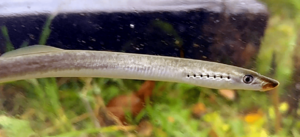Brook lamprey facts for kids
Quick facts for kids Brook lamprey |
|
|---|---|
 |
|
| Conservation status | |
| Scientific classification | |
| Synonyms | |
|
The brook lamprey (Lampetra planeri) is a small fish. It lives only in freshwater environments like streams and rivers. This species is also known as the European brook lamprey. It is a type of lamprey, which are ancient fish without jaws.
Contents
What Does a Brook Lamprey Look Like?
The brook lamprey is a common fish found only in Europe. Adult brook lampreys are usually about 12 to 14 centimeters long. Their bodies are long and thin. They are dark blue or green on top. Their sides are yellowish-white, and their bellies are pure white.
Like all lampreys, they do not have paired fins. Instead of jaws, they have a round sucking mouth. This mouth is full of blunt teeth. They have one nostril and seven small gill openings. These openings are on each side of their body, behind their eyes. You can tell a brook lamprey from a similar fish, the river lamprey, by looking at its two back fins. The brook lamprey's fins are closer together.
Where Do Brook Lampreys Live?
Brook lampreys live in small streams and larger rivers. You can find them across northern Europe. They also live in Portugal, southern France, Italy, and Sardinia. They are found in the Balkans and the upper parts of the Volga River.
Life Cycle of the Brook Lamprey
Unlike some other lamprey species, adult brook lampreys do not travel to the sea. They also do not feed on other animals. During their spawning time, adult brook lampreys do not eat at all.
Spawning and Eggs
Brook lampreys lay their eggs in spring and summer. They choose shallow areas of streams or sometimes lakes. They prefer gravelly spots near soft mud. Both male and female lampreys help build nests. They move small rocks with their mouths. They also fan away smaller bits of dirt with their tails.
The male and female release their sperm and eggs into the nest at the same time. A female can lay several thousand eggs. After laying their eggs, adult brook lampreys die.
Young Lampreys (Ammocoetes)
The eggs hatch within a few days. The young larvae, called ammocoetes, then bury themselves in soft mud. Only their mouths stick out. These young lampreys cannot see. They filter feed on tiny bits of dead plants and other organic matter. They live like this for three to five years.
After about four years as ammocoetes, they change into adults. This change happens in the fall. During this time, their eyes and sucking mouth develop. Their gut also shrinks and stops working. This full change can take up to a year. It's interesting because they grow teeth when they can no longer eat. However, lampreys use their teeth to grip stones. This helps them build their nests.
Other Information
- Animal, Smithsonian Institution, 2005
- Fishbase



